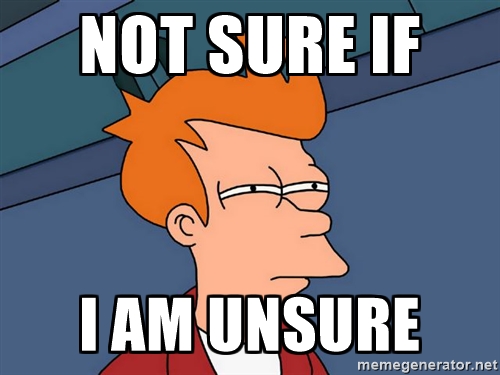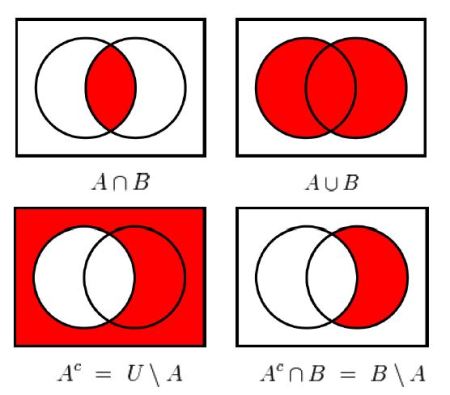
What is Probability?
the value or state of presence probable; the range to some degree is likely to happen or be the case. Probability is defined as a number between 0 and 1 (where 0 shows impossibility and 1 shows certainty).
Probability is day to day used term, for example we always say whenever we toss a coin is ‘head may come’. This statement has a certain uncertainty.
Relation between two sets A and B:
∩ = intersection
U= Union


Lets get a clear view on three sets A,B,C

Probability:
Let E be an event and S be the sample space. Then probability of the event E can be defined as
P(E) = n(E)/n(S)
where P = probability, n= number of cases
Let’s start with simpler example:
- What is the probability of getting head?
Solution: n(S)= 2 … (either Head may come or Tail at a time, which means 2 possibilities)
n(E)= 1… (no. of heads presents in sample)
P(Head)= ½ = 0.5
- Two dice are rolled. What is the probability that the sum on the top face of both the dice will be greater than equal to 10?
Solution:
Total number of outcomes possible when a die is rolled = 6 (∵ any one face out of the 6 faces)
Hence, total number of outcomes possible two dice are rolled, n(S) = 6 × 6 = 36
E = Getting a sum greater than 9 when the two dice are rolled = {(4, 6), {5, 5}, {5, 6}, {6, 4}, {6, 5}, (6, 6)}
Hence, n(E) = 6
P(getting sum >= 10) = 6/36 = 1/36
Q. Two dice are rolled, find the probability that the sum is
a) less than 2
b) equal to 5
c) less than 14
Solution
a) The sample space S of two dice is shown below.S = { (1,1),(1,2),(1,3),(1,4),(1,5),(1,6)
(2,1),(2,2),(2,3),(2,4),(2,5),(2,6)
(3,1),(3,2),(3,3),(3,4),(3,5),(3,6)
(4,1),(4,2),(4,3),(4,4),(4,5),(4,6)
(5,1),(5,2),(5,3),(5,4),(5,5),(5,6)
(6,1),(6,2),(6,3),(6,4),(6,5),(6,6) }
Let E be the event “sum equal to 1”. There are no outcomes which correspond to a sum equal to 1, hence
P(E) = n(E) / n(S) = 0 / 36 = 0
- b) Three possible outcomes give a sum equal to 4: E = {(1,3),(2,2),(3,1)}, hence.P(E) = n(E) / n(S) = 3 / 36 = 1 / 12
- c) All possible outcomes, E = S, give a sum less than 13, hence.P(E) = n(E) / n(S) = 36 / 36 = 1
Let’s touch higher level of Probability question with same logic we used earlier coin problem with some combination concept.
Q. If 100 coins are tossed, what is the probability that exactly 50 heads will be showing.?
Solution:
One coin is tossed , possible outcome = 2 = 21 (H,T)
Two coin are tossed, possible outcome =4= 22 ( HT,TH,TT,HH)
Three Coins are tossed, possible outcome =8= 23 (TTT,HHH,HHT,HTT,THT,TTH,THH,HTH)
Similarly for 100 coins ,possible outcome = 2100
No. of combination of getting 50 heads over 100 coins = 100C50
Probability (50 heads) = 100C50/2100
Alternative:
THE BINOMIAL EXPANSION
P( r success in n trials) = nCr (p) r (q) n-r ( p= favorable outcome ; q= 1-p 😉
P(getting 50 head out of 100 coin) = 100C50 (1/2) 50 (1/2) 50
Basic concept on drawing a card:
In a pack or deck of 52 playing cards, they are divided into 4 suits of 13 cards each i.e. spades ♠ hearts ♥, diamonds ♦, clubs ♣.
Cards of Spades and clubs are black cards.
Cards of hearts and diamonds are red cards.
The card in each suit, are ace, king, queen, jack or knaves, 10, 9, 8, 7, 6, 5, 4, 3 and 2.
King, Queen and Jack (or Knaves) are face cards. So, there are 12 face cards in the deck of 52 playing cards.
Let’s do a single problem to clear out all concept of cards
Q. A card is drawn from a well shuffled pack of 52 cards. Find the probability of:
(i) ‘2’ of spades
(ii) a jack
(iii) a king of red colour
(iv) a card of diamond
(v) a king or a queen
(vi) a non-face card
(vii) a black face card
(viii) a black card
(ix) a non-ace
(x) non-face card of black colour
(xi) neither a spade nor a jack
(xii) neither a heart nor a red king
Solution:
In a playing card there are 52 cards.
Therefore the total number of possible outcomes = 52
(i) ‘2’ of spades:
Number of favourable outcomes i.e. ‘2’ of spades is 1 out of 52 cards.
Therefore, probability of getting ‘2’ of spade
Number of favorable outcomes
P(A) = Total number of possible outcome
= 1/52
(ii) a jack
Number of favourable outcomes i.e. ‘a jack’ is 4 out of 52 cards.
Therefore, probability of getting ‘a jack’
Number of favorable outcomes
P(B) = Total number of possible outcome
= 4/52
= 1/13
(iii) a king of red colour
Number of favourable outcomes i.e. ‘a king of red colour’ is 2 out of 52 cards.
Therefore, probability of getting ‘a king of red colour’
Number of favorable outcomes
P(C) = Total number of possible outcome
= 2/52
= 1/26
(iv) a card of diamond
Number of favourable outcomes i.e. ‘a card of diamond’ is 13 out of 52 cards.
Therefore, probability of getting ‘a card of diamond’
Number of favorable outcomes
P(D) = Total number of possible outcome
= 13/52
= 1/4
(v) a king or a queen
Total number of king is 4 out of 52 cards.
Total number of queen is 4 out of 52 cards
Number of favorable outcomes i.e. ‘a king or a queen’ is 4 + 4 = 8 out of 52 cards.
Therefore, probability of getting ‘a king or a queen’
Number of favorable outcomes
P(E) = Total number of possible outcome
= 8/52
= 2/13
(vi) a non-face card
Total number of face card out of 52 cards = 3 times 4 = 12
Total number of non-face card out of 52 cards = 52 – 12 = 40
Therefore, probability of getting ‘a non-face card’
Number of favorable outcomes
P(F) = Total number of possible outcome
= 40/52
= 10/13
(vii) a black face card:
Cards of Spades and Clubs are black cards.
Number of face card in spades (king, queen and jack or knaves) = 3
Number of face card in clubs (king, queen and jack or knaves) = 3
Therefore, total number of black face card out of 52 cards = 3 + 3 = 6
Therefore, probability of getting ‘a black face card’
Number of favorable outcomes
P(G) = Total number of possible outcome
= 6/52
= 3/26
(viii) a black card:
Cards of spades and clubs are black cards.
Number of spades = 13
Number of clubs = 13
Therefore, total number of black card out of 52 cards = 13 + 13 = 26
Therefore, probability of getting ‘a black card’
Number of favorable outcomes
P(H) = Total number of possible outcome
= 26/52
= 1/2
(ix) a non-ace:
Number of ace cards in each of four suits namely spades, hearts, diamonds and clubs = 1
Therefore, total number of ace cards out of 52 cards = 4
Thus, total number of non-ace cards out of 52 cards = 52 – 4
= 48
Therefore, probability of getting ‘a non-ace’
Number of favorable outcomes
P(l) = Total number of possible outcome
= 48/52
= 12/13
(x) non-face card of black colour:
Cards of spades and clubs are black cards.
Number of spades = 13
Number of clubs = 13
Therefore, total number of black card out of 52 cards = 13 + 13 = 26
Number of face cards in each suits namely spades and clubs = 3 + 3 = 6
Therefore, total number of non-face card of black colour out of 52 cards = 26 – 6 = 20
Therefore, probability of getting ‘non-face card of black colour’
Number of favorable outcomes
P(J) = Total number of possible outcome
= 20/52
= 5/13
(xi) neither a spade nor a jack
Number of spades = 13
Total number of non-spades out of 52 cards = 52 – 13 = 39
Number of jack out of 52 cards = 4
Number of jack in each of three suits namely hearts, diamonds and clubs = 3
[Since, 1 jack is already included in the 13 spades so, here we will take number of jacks is 3]
Neither a spade nor a jack = 39 – 3 = 36
Therefore, probability of getting ‘neither a spade nor a jack’
Number of favorable outcomes
P(K) = Total number of possible outcome
= 36/52
= 9/13
(xii) neither a heart nor a red king
Number of hearts = 13
Total number of non-hearts out of 52 cards = 52 – 13 = 39
Therefore, spades, clubs and diamonds are the 39 cards.
Cards of hearts and diamonds are red cards.
Number of red kings in red cards = 2
Therefore, neither a heart nor a red king = 39 – 1 = 38
[Since, 1 red king is already included in the 13 hearts so, here we will take number of red kings is 1]
Therefore, probability of getting ‘neither a heart nor a red king’
Number of favorable outcomes
P(L) = Total number of possible outcome
= 38/52
= 19/26
(Written by Atul)
